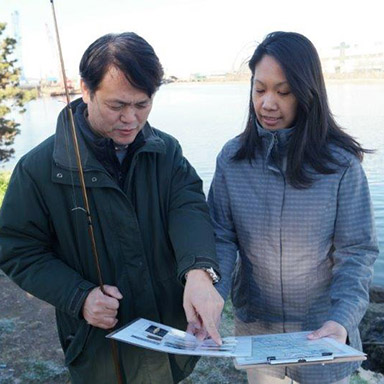This page may be viewed in: English
Protect Your Health
The only Duwamish River seafood that is safe to eat is salmon. In the Duwamish River, the seafood that spend their entire lives in the river (perch, sole, flounder, crab, mussels, and clams) are unsafe to eat. They have high levels of toxic chemicals (such as PCBs) that you cannot see. Learn how to protect your health while fishing for seafood that is safe to catch and eat. Eating Seafood—Public Health Seattle and King County: Fun to Catch, Toxic to Eat.
Duwamish Fishing Videos
These videos were produced in partnership with the Duwamish Community Health Advocates, Public Health–Seattle & King County, the US Environmental Protection Agency Region 10, and the Washington Department of Fish and Wildlife.
English:
Spanish:
Vietnamese:
Khmer:
2016 Fishers Study
Salmon, which migrate through the Duwamish, are safe to eat. However, people are exposed to contamination from the Duwamish River if they eat fish, crabs, and clams that are ‘resident species’ (those that live their entire lives in the river). As a part of the effort to reduce human exposure to contamination from the river, LDWG, EPA, and Ecology worked with the local non-profit ECOSS to complete a study in 2016 to learn more about people who fish on the Lower Duwamish Waterway and how best to communicate about the risk of eating resident seafood from the river.
This Fishers Study showed that people who fish from the Duwamish River speak many languages and like to get information in different ways. Understanding this, EPA and Seattle-King County Public Health developed a plan, with input from the community, to educate community members and fishers about the risks of consuming resident seafood from the river.
EPA’s Duwamish Seafood Consumption Institutional Control Plan
The goal of EPA’s Duwamish Seafood Consumption Institutional Control Program is to promote culturally appropriate, healthy actions that protect the health and well-being of fishing communities, especially pregnant women, nursing moms, and young children, from the contaminated resident seafood in the Duwamish River Superfund site.
In January 2017, EPA entered into a Cooperative Agreement with Public Health Seattle-King County to establish a community-based Healthy Seafood Consumption Institutional Control (IC) Program for the Lower Duwamish Waterway Superfund Site. The program uses a community-based participatory process to develop culturally-appropriate IC tools that can be implemented throughout the cleanup of the Lower Duwamish Waterway Superfund Site. The program will promote healthy seafood consumption before, during, and after the cleanup.
 ECOSS staff explaining safe fish consumption tips to a fisher on the river.
ECOSS staff explaining safe fish consumption tips to a fisher on the river.

The Fisher Study found that more than 20 ethnic/language groups fish on the Duwamish River. Fishers from Asian, Pacific Islander (API), and Latino immigrant communities are catching, eating and sharing the contaminated seafood from the river. The health warning signs have not been effective in reaching fishers who speak little to no English – most of these fishers speak Vietnamese, Cambodian (Khmer) and Spanish.
Read more
Institutional Controls Implementation and Assurance Plan Fact Sheet – EPA
Fun to Catch, Toxic to Eat Program – King County
For more information about this program, please contact:
- US EPA: Piper Peterson, USEPA Superfund Project Manager, (206) 553-4951, peterson.piper@epa.gov
- US EPA: Laura Knudsen, USEPA Lead Community Involvement Coordinator, (206) 553-1838, knudsen.laura@epa.gov
- Public Health Seattle & King County: Khanh Ho, (206) 263-0906, khanh.ho@kingcounty.gov
